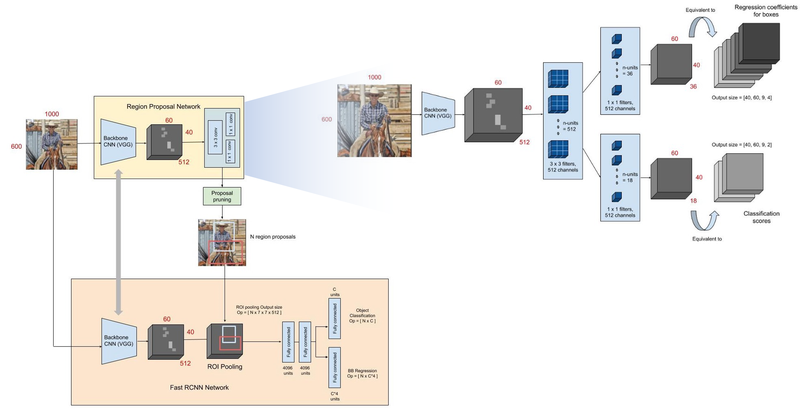01. Faster RCNN

1. Faster RCNN의 구조

- RCNN, Fast RCNN과 Faster RCNN의 가장 큰 차이점
- Selective Search를 Region Proposal Network(RPN) 로 바꿈.
- RPN : RoI가 될 후보군인 Anchor Box를 무수히 만든다.
- 그 후 Bounding Box Regression를 통해서 괜찮은 RoI를 딥러닝을 통해 학습한다.
- Classification을 통해 그것이 Object인지 아닌지를 판단한다.
- RPN을 통해 얻은 결과에 Object Classification을 통해서 해당 RoI에 있는 Object가 어떤 Class인지 구분하고, Bounding Box Regression을 실행한다.
02. 실습
# Tensorflow와 Tensoflow Hub에 있는 이미 학습된 모델을 활용하기 위한 모듈
import tensorflow as tf
import tensorflow_hub as hub
# 이미지를 다운로드하는 데에 사용하는 모듈
import matplotlib.pyplot as plt
import tempfile
from six.moves.urllib.request import urlopen
from six import BytesIO
# 이미지에 선과 폰트를 넣기 위한 모듈
import numpy as np
from PIL import Image
from PIL import ImageColor
from PIL import ImageDraw
from PIL import ImageFont
from PIL import ImageOps
# Detection하는 데에 소요된 시간을 점검하기 위한 모듈
import time
- 이미지 시각화 하는 함수
def display_image(image):
fig = plt.figure(figsize=(20, 15))
plt.grid(False)
plt.imshow(image)
# 이미지를 resizing하는 함수
def download_and_resize_image(url, new_width=256, new_height=256, display=False):
_, filename = tempfile.mkstemp(suffix=".jpg")
response = urlopen(url)
image_data = response.read()
image_data = BytesIO(image_data) # 이미지 읽기
pil_image = Image.open(image_data)
pil_image = ImageOps.fit(pil_image, (new_width, new_height), Image.ANTIALIAS) # 이미지 조정
pil_image_rgb = pil_image.convert("RGB") #RBG로 변환
pil_image_rgb.save(filename, format="JPEG", quality=90) # 이미지 저장
print("Image downloaded to %s." % filename)
if display:
display_image(pil_image)
return filename
- Bounding Box를 만드는 함수
def draw_bounding_box_on_image(image,
ymin, xmin, ymax, xmax,
color,
font,
thickness=4,
display_str_list=()):
draw = ImageDraw.Draw(image)
im_width, im_height = image.size
(left, right, top, bottom) = (xmin * im_width, xmax * im_width,
ymin * im_height, ymax * im_height)
# BBox 테두리 그리기
draw.line([(left, top), (left, bottom), (right, bottom), (right, top),
(left, top)],
width=thickness,
fill=color)
display_str_heights = [font.getsize(ds)[1] for ds in display_str_list]
total_display_str_height = (1 + 2 * 0.05) * sum(display_str_heights)
if top > total_display_str_height:
text_bottom = top
else:
text_bottom = top + total_display_str_height
for display_str in display_str_list[::-1]:
text_width, text_height = font.getsize(display_str)
margin = np.ceil(0.05 * text_height)
draw.rectangle([(left, text_bottom - text_height - 2 * margin),
(left + text_width, text_bottom)],
fill=color)
draw.text((left + margin, text_bottom - text_height - margin),
display_str,
fill="black",
font=font)
text_bottom -= text_height - 2 * margin
- 이미지 위에 class 이름과 score를 나타내는 함수
# BBox 그리기
def draw_boxes(image, boxes, class_names, scores, max_boxes=10, min_score=0.1):
colors = list(ImageColor.colormap.values())
try:
font = ImageFont.truetype("/usr/share/fonts/truetype/liberation/LiberationSansNarrow-Regular.ttf",
25)
except IOError:
print("Font not found, using default font.")
font = ImageFont.load_default()
# BBox 그리기 적용
for i in range(min(boxes.shape[0], max_boxes)):
if scores[i] >= min_score:
ymin, xmin, ymax, xmax = tuple(boxes[i]) # 박스 좌표값
display_str = "{}: {}%".format(class_names[i].decode("ascii"),
int(100 * scores[i]))
color = colors[hash(class_names[i]) % len(colors)]
image_pil = Image.fromarray(np.uint8(image)).convert("RGB")
draw_bounding_box_on_image(
image_pil,
ymin,
xmin,
ymax,
xmax,
color,
font,
display_str_list=[display_str])
np.copyto(image, np.array(image_pil))
return image
- 이미지 불러오기
image_url = "https://upload.wikimedia.org/wikipedia/commons/thumb/d/db/Torneo_beach_handball.jpg/640px-Torneo_beach_handball.jpg"
downloaded_image_path = download_and_resize_image(image_url, 1280, 856, True) # new_width와 new_height를 변경해 보세요.
- pretrained 된 faster RCNN모델 사용
# tfhub에서 Pre-trained 모델을 사용
module_handle = "https://tfhub.dev/google/faster_rcnn/openimages_v4/inception_resnet_v2/1"
detector = hub.load(module_handle).signatures['default'] # detector에 사용할 모듈 저장
def load_img(path):
img = tf.io.read_file(path)
img = tf.image.decode_jpeg(img, channels=3)
return img
- Detector 실행함수
def run_detector(detector, path):
img = load_img(path)
converted_img = tf.image.convert_image_dtype(img, tf.float32)[tf.newaxis, ...]
# 소요시간 측정
start_time = time.time()
result = detector(converted_img)
end_time = time.time()
result = {key:value.numpy() for key,value in result.items()}
# 이미지 추론 개수와 추론 시간 출력
print("Found %d objects." % len(result["detection_scores"]))
print("Inference time: ", end_time-start_time)
# 이미지 내 박스로 entity, scores를 추가하여 출력
image_with_boxes = draw_boxes(
img.numpy(), result["detection_boxes"],
result["detection_class_entities"], result["detection_scores"])
display_image(image_with_boxes)run_detector(detector, downloaded_image_path)
'하루 30분 컴퓨터 비전 공부하기' 카테고리의 다른 글
| Vision Linear Classifiers가 입력 데이터를 처리하고 결과를 해석하는 방식 (1) | 2024.12.06 |
|---|---|
| CV(10) Image Classification/코드 실전편 (0) | 2023.10.31 |
| CV(8) Segmentation과 U-Net (0) | 2023.10.31 |
| CV(7) Object Detection과 R-CNN (0) | 2023.10.27 |
| CV(6) CNN 정복하기 - Transfer Learning 기본 (1) | 2023.10.27 |



